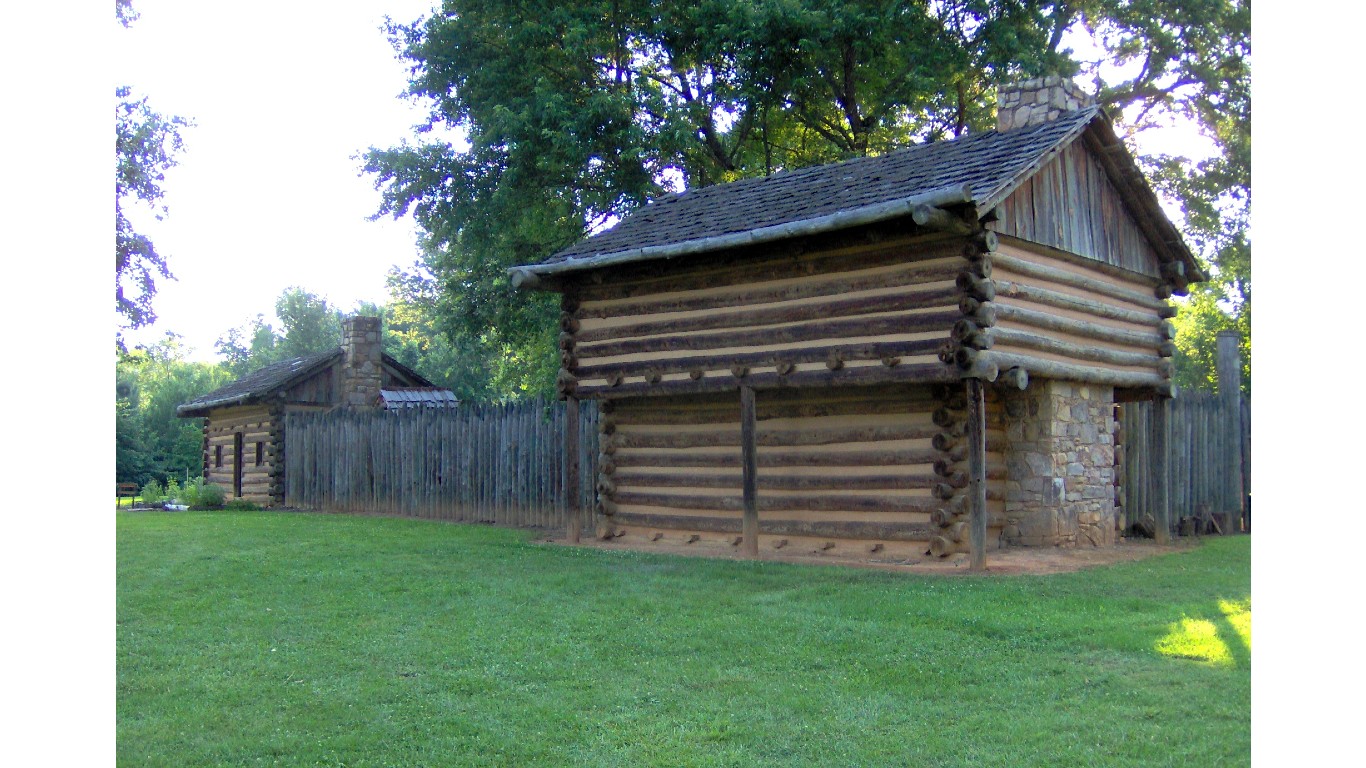
National, state, and local parks are known for their natural beauty and recreational opportunities. Yet many of these landmarks started life as military installations, dating back to the Revolutionary War, the War of 1812, and the Civil War. Others saw action when the U.S. Army clashed with Native Americans. Even after those conflicts, several were in use during the Second World War. (Here’s how every war in U.S. history ended.)
To determine 33 of the oldest early American forts, encompassing fortifications that were built between 1775 and 1851, 24/7 consulted sources including the National Park Service and various state and regional tourism websites. (Sites that contain only unrestored earthworks were largely excluded.) In many cases, the original forts have not survived intact, but the sites contain ruins, reconstructed facilities, or historically accurate replicas on the original grounds. Through extensive renovation by federal, state, and local authorities, many of these remain open for tourists who want a glimpse into the country’s past. (To see fortifications that predate those on our list, see the oldest military forts built before America was a country.)
Click here to see 33 forts that are as old as America
Even in their heyday, many forts were not exclusively Army or naval outposts. Instead, they were used initially or partially for commerce or as a stopping point for westbound travelers. Fort Vancouver in Washington, in fact, was a fur trading outpost and never a military base. Others, like the Fort Osage in Sibley, Missouri, served two purposes: It housed soldiers guarding the newly acquired Louisiana Territory as well as serving as a way station for the Lewis and Clark Expedition.
Two of the forts here, incidentally, weren’t originally in the possession of the British or The Presidios of San Francisco and Santa Barbara were established by Spain to protect its California colony.
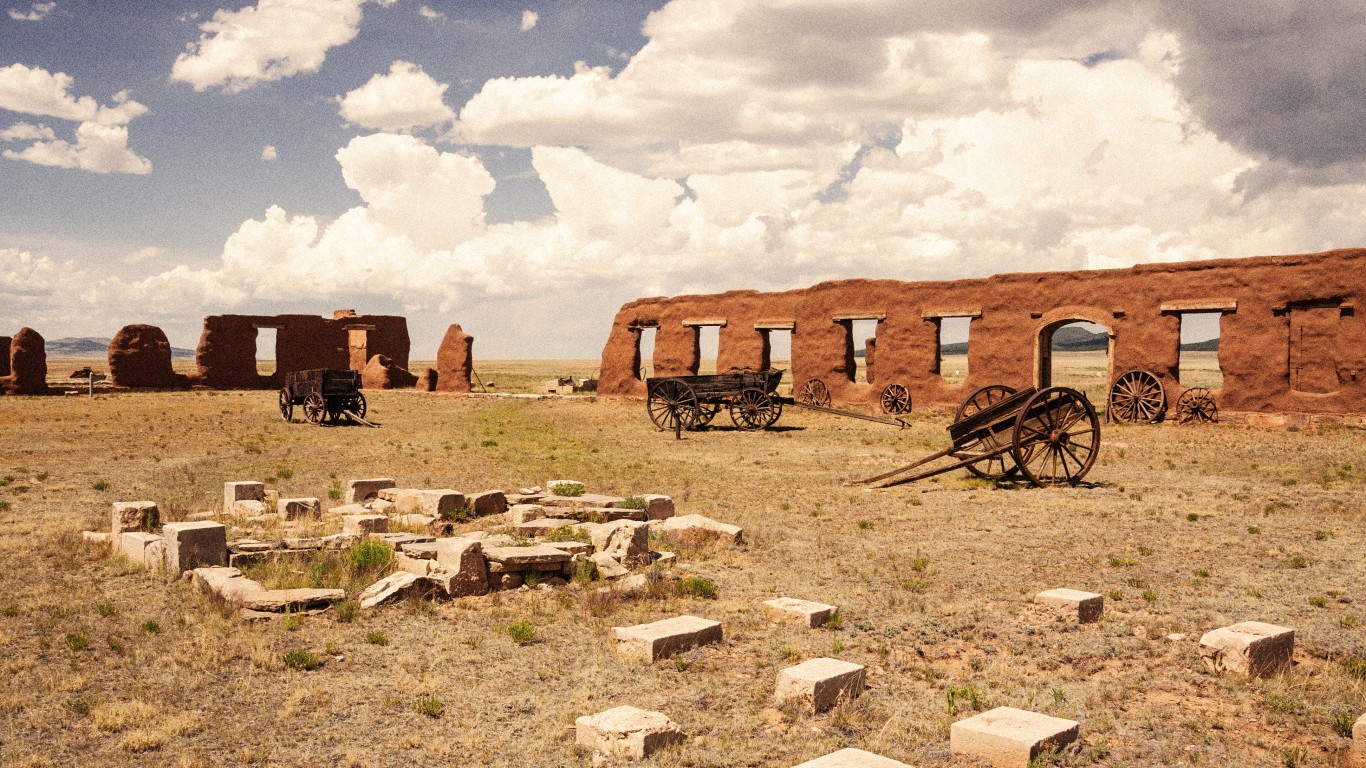
Fort Union
> Location: Watrous, New Mexico
> Built: 1851
Built along the Sante Fe Trail in New Mexico Territory, Fort Union was originally provisioned by farmers and ranchers in the area, and even contained a grist mill. In 1862, the fort was pivotal in fending off an attack by Confederate soldiers who invaded New Mexico from Texas. In the early 1870s, the 8th Cavalry was stationed there. Later, the 9th Cavalry used it as its headquarters in the late 1870s during the Apache Wars.
[in-text-ad]
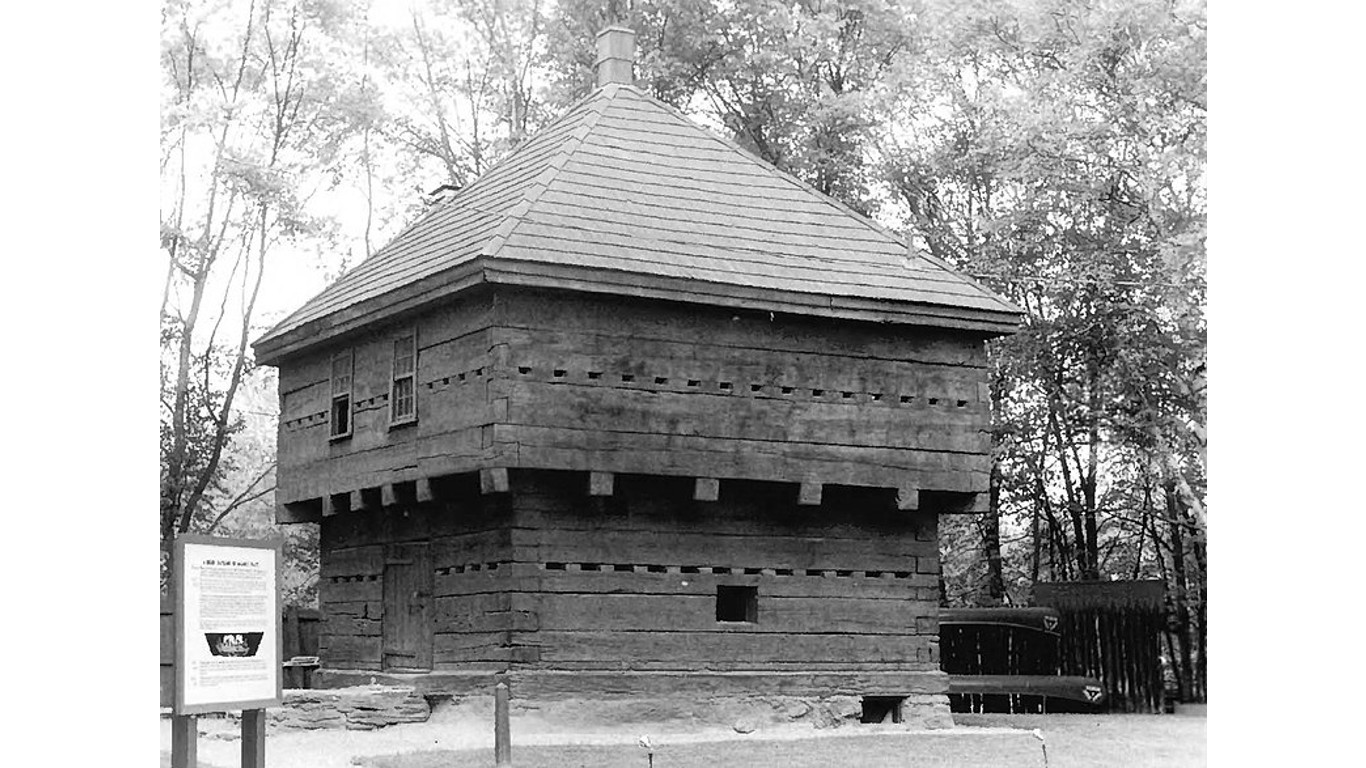
Fort Kent
> Location: Fort Kent, Maine
> Built: 1838
Under the 1783 Treaty of Paris, Great Britain recognized the U.S., but that treaty stirred up tensions between Maine and neighboring New Brunswick, Canada, leading to the construction of Fort Kent. Hostilities ended by 1842, but U.S. troops remained until 1845. Subsequently, the fort was sold to private organizations and then to the state, which converted it to a historic park.
Fort Christmas
> Location: Christmas, Florida
> Built: 1837
Built during the Second Seminole War (1835 to 1842), Fort Christmas housed 2,000 U.S. Army soldiers and Alabama volunteers. In 1845, several years after the war ended, the fort was abandoned.
Fort Foster
> Location: Zephyrhills, Florida
> Built: 1836
Constructed during the Second Seminole War, Fort Foster defended a bridge along the Hillsborough River. The site was garrisoned sporadically between December 1836 and April 1838. It reopened in 1849 when skirmishes with the Seminoles heated up. Reconstructed in 1980, it is now closed to the public.
[in-text-ad-2]

Bent’s Old Fort
> Location: La Junta, Colorado
> Built: 1833
Built in 1833 by Charles and William Bent and Ceran St. Vrain as a fur trading post, Bent’s Old Fort was the only white American permanent outpost on the Sante Fe Trail between Missouri and the Mexican settlements for its 16-year history. During the Mexican-American War in 1846, Colonel Stephen Watts Kearny’s “Army of the West” used it as a staging area. The fort was abandoned in 1849 after a cholera epidemic.

Fort Macon
> Location: Atlantic Beach, North Carolina
> Built: 1826
During March and April of 1862, Fort Macon was the site of a heated battle between the Confederate and Union armies. Union forces gained control of the fort and remained there during the Reconstruction era, during which it was used as a prison. Although the fort was deactivated in 1877, state troops occupied it during the Spanish-American War in 1898. By 1902, the U.S. Army had left the fort.
[in-text-ad]
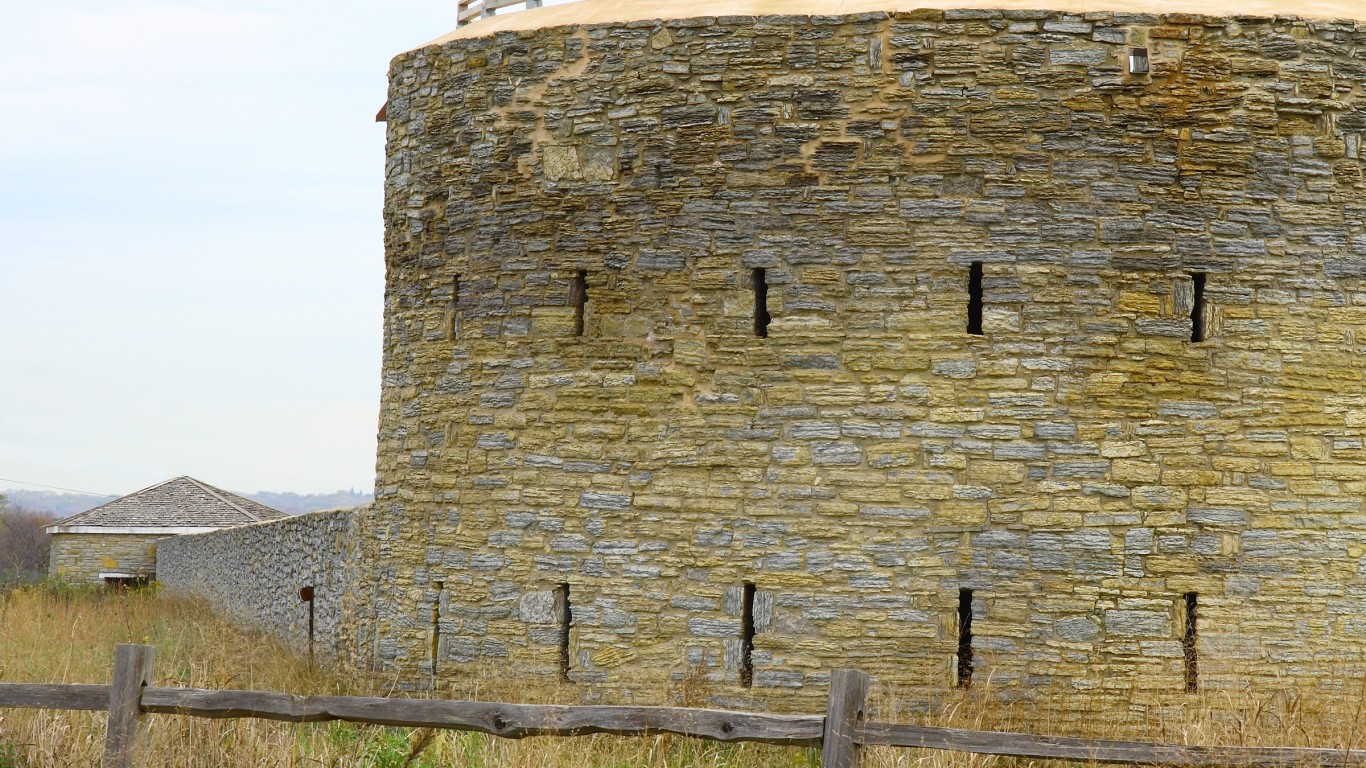
Fort Snelling
> Location: Fort Snelling, Minnesota
> Built: 1825
Fort Snelling housed government forces during the Dakota War of 1862, and served as a recruiting station during the Civil War, Spanish American War, and both world wars before its decommission in 1946. The fort was also involved in the infamous Dred Scott v. Sandford decision. The fort allowed soldiers to bring their slaves to the site. Among them were Dred Scott and Harriet Robinson Scott, who sued for their freedom because Minnesota was “free territory.” In denying the claim, the Supreme Court ruled in 1857 that African-Americans, whether free or enslaved, had no right to American citizenship and were thus unprotected by the Constitution.
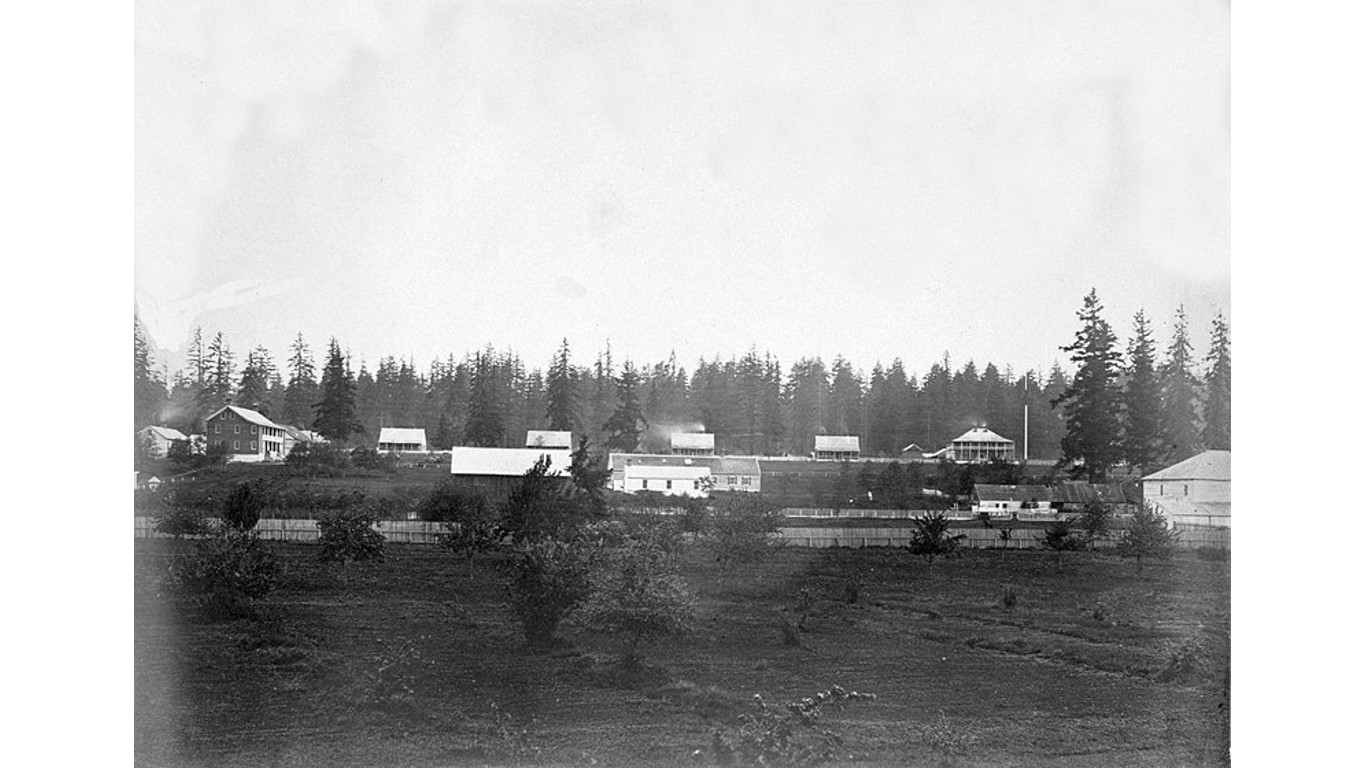
Fort Vancouver
> Location: Vancouver, Washington
> Built: 1825
Fort Vancouver wasn’t established as a military base. Instead, it was originally a fur trading outpost and headquarters of the Hudson’s Bay Company’s Columbia Department. Demand from Europe for fur-based textiles in the early 19th century pushed the Hudson’s Bay company to expand operations in North America and the Pacific Northwest. In addition to its commercial use, Fort Vancouver was a supply stop for settlers traveling the Oregon Trail.
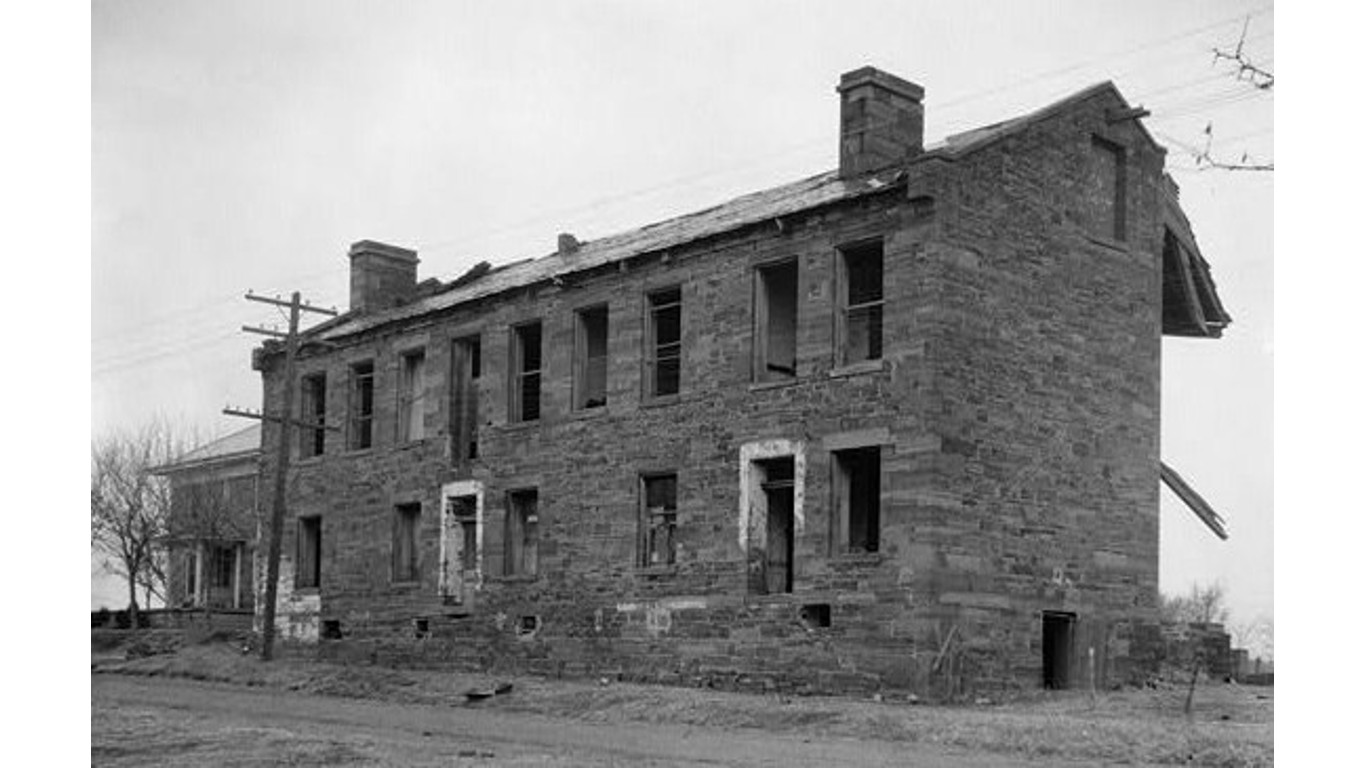
Fort Gibson
> Location: Fort Gibson, Oklahoma
> Built: 1824
Originally established in 1824 to maintain peace between the Osage and Cherokee peoples, Fort Gibson was a starting point for many westward expeditions. In use during the Native American removal period, the fort was abandoned in 1857. During the Civil War, it was reactivated and renamed Fort Blunt, serving as the Union Army headquarters in Indian Territory. The Union Army continued to stay at the fort through Reconstruction and the Indian Wars periods. It was abandoned in 1890.
[in-text-ad-2]
Fort Macomb
> Location: New Orleans, Louisiana
> Built: 1822
Built along the Chef Menteur Pass, a water route from the Gulf of Mexico to Lake Pontchartrain, Fort Macomb was erected seven years after British forces attacked New Orleans during the War of 1812. In 1861, Confederate troops from Louisiana took over the fort, but when the Union army seized New Orleans, it occupied the site. After the barracks caught fire in 1867, the U.S. Army left the fort, and it was decommissioned in 1871. Now in a state of disrepair, Fort Macomb is closed to the public.
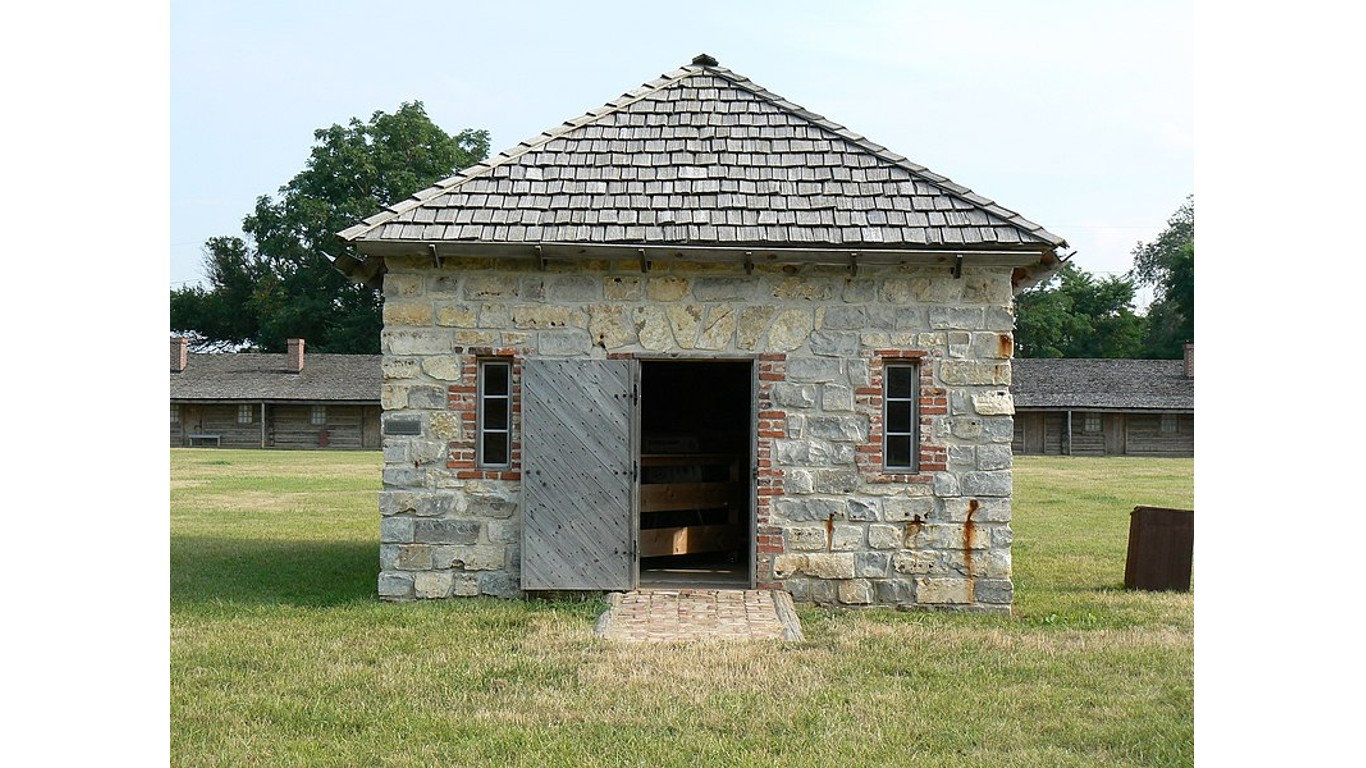
Fort Atkinson
> Location: Fort Calhoun, Nebraska
> Built: 1819
During the Lewis and Clark Expedition of the early 1800s, William Clark recognized that a hill above the Missouri River would be a good location for a fort, and in 1819, a fort was built here. At one time, it housed 1,200 soldiers, nearly a quarter of the U.S. Army at the time. Its purpose was to keep the peace between fur traders and Native American tribes in the region. The fort was in service from 1820 to 1827.
[in-text-ad]
Fort Pike
> Location: New Orleans, Louisiana
> Built: 1819
Built during the War of 1812 to guard Rigolets Pass – a strait from the Gulf of Mexico via Lake Borgne to Lake Pontchartrain in New Orleans – Fort Pike came under the control of the Louisiana Continental Guard in 1861, just before Louisiana joined the Confederacy. The following year, Union forces captured New Orleans and Confederate troops fled the fort. By 1890, the U.S. Army had abandoned Fort Pike. Damage from a series of hurricanes, including Hurricane Katrina, forced the site to close several times. In 2015, it was permanently closed due to state budget cuts.
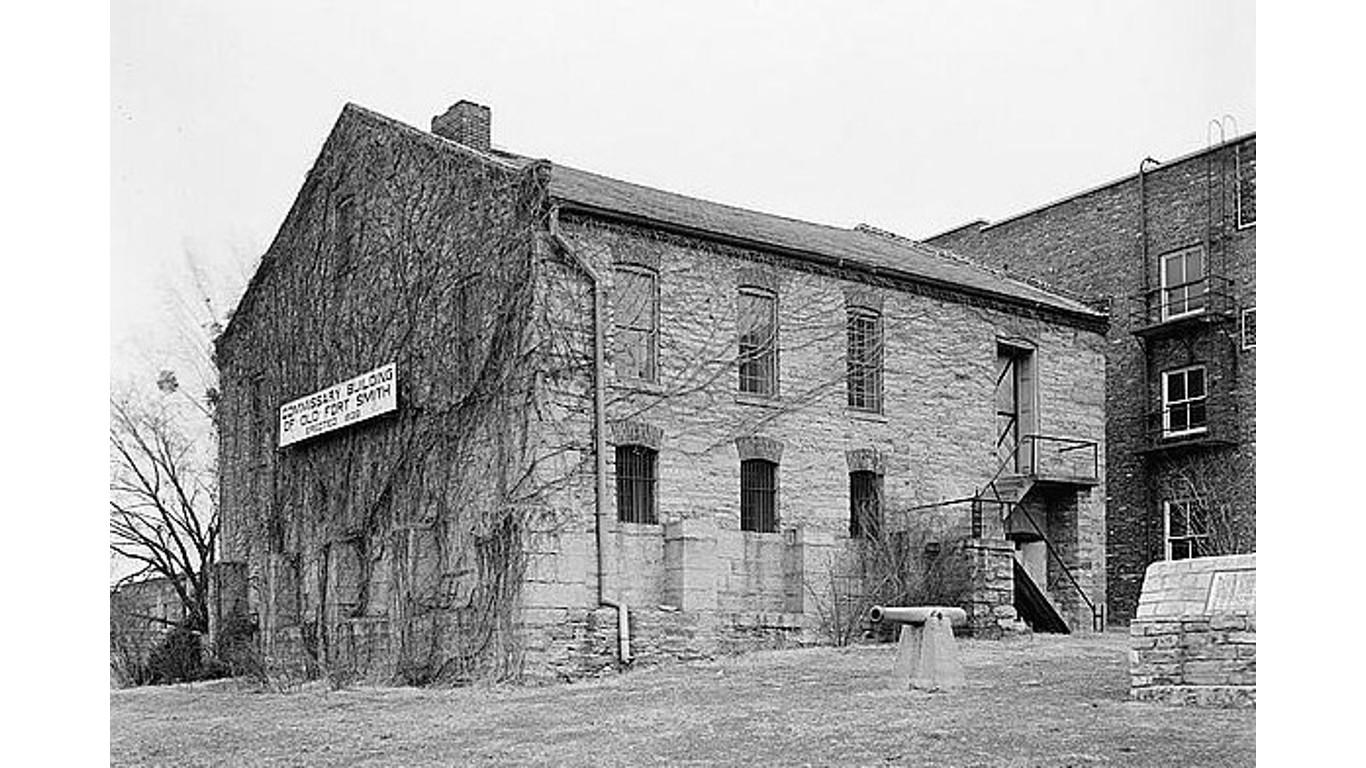
Fort Smith
> Location: Fort Smith, Arkansas
> Built: 1817
Major William Bradford established Fort Smith in 1817 to maintain peace between the Osage and Cherokee peoples, who had migrated west. It later became the first site of the U.S. District Court for the Western District of Arkansas, which included western Arkansas and the Indian Territory. The U.S. Army left the fort in 1824. Fort Smith was a stopover for the Choctaw and Cherokee people during the “Trail of Tears,” a period when Native Americans were removed from the Southeast.

Fort Holmes
> Location: Mackinac Island, Michigan
> Built: 1814
Towering over the highest point of Mackinac Island, Fort Holmes was originally constructed and occupied by British troops during the War of 1812 under the name Fort George. The U.S. took over the fort under the Treaty of Ghent in 1815. It was later renamed Fort Holmes in honor of Major Andrew Holmes, who died in the Battle of Mackinac Island in 1814. Soon after the war, the fort was abandoned and has undergone reconstruction efforts since the 1930s.
[in-text-ad-2]
Fort Osage
> Location: Sibley, Missouri
> Built: 1808
Fort Osage served two purposes: Housing soldiers to guard the recently acquired Louisiana Purchase and protecting the U.S. Factory Trade House on the site. William Clark, joint commander of the Lewis and Clark expedition, directed its construction, along with Captain Eli Clemson, in 1808. By 1827, traders and soldiers had abandoned the fort. Reconstruction began in 1941, and it was named a National Historic Landmark in 1961.
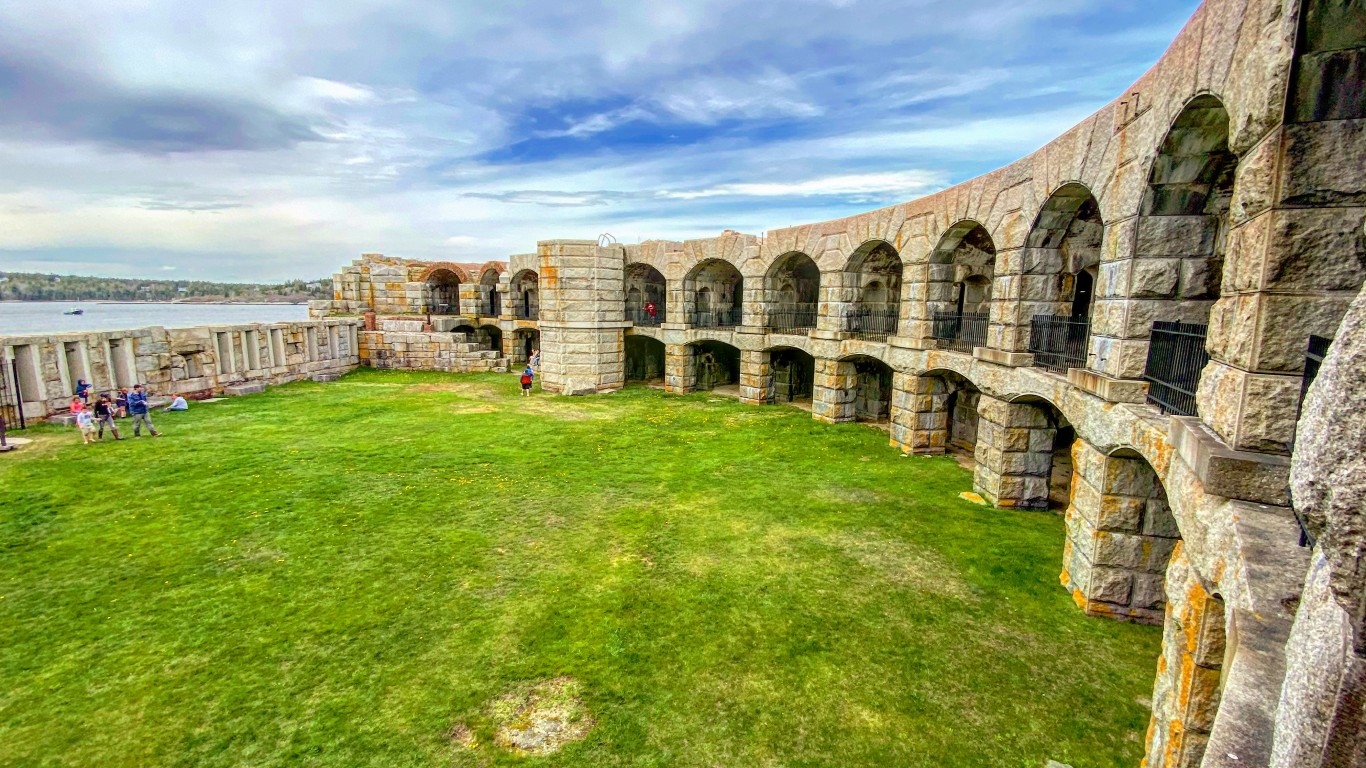
Fort Popham
> Location: Phippsburg, Maine
> Built: 1808
Fort Popham began as a small installation in 1808 to enforce the embargo of 1807 and saw action during the War of 1812. Construction of an expanded fort began in earnest in 1862 and ended in 1869. During the Civil War, it protected Maine’s capital, Augusta, from Confederate forces. In 1969, it was designated one of the National Register of Historic Places.
[in-text-ad]
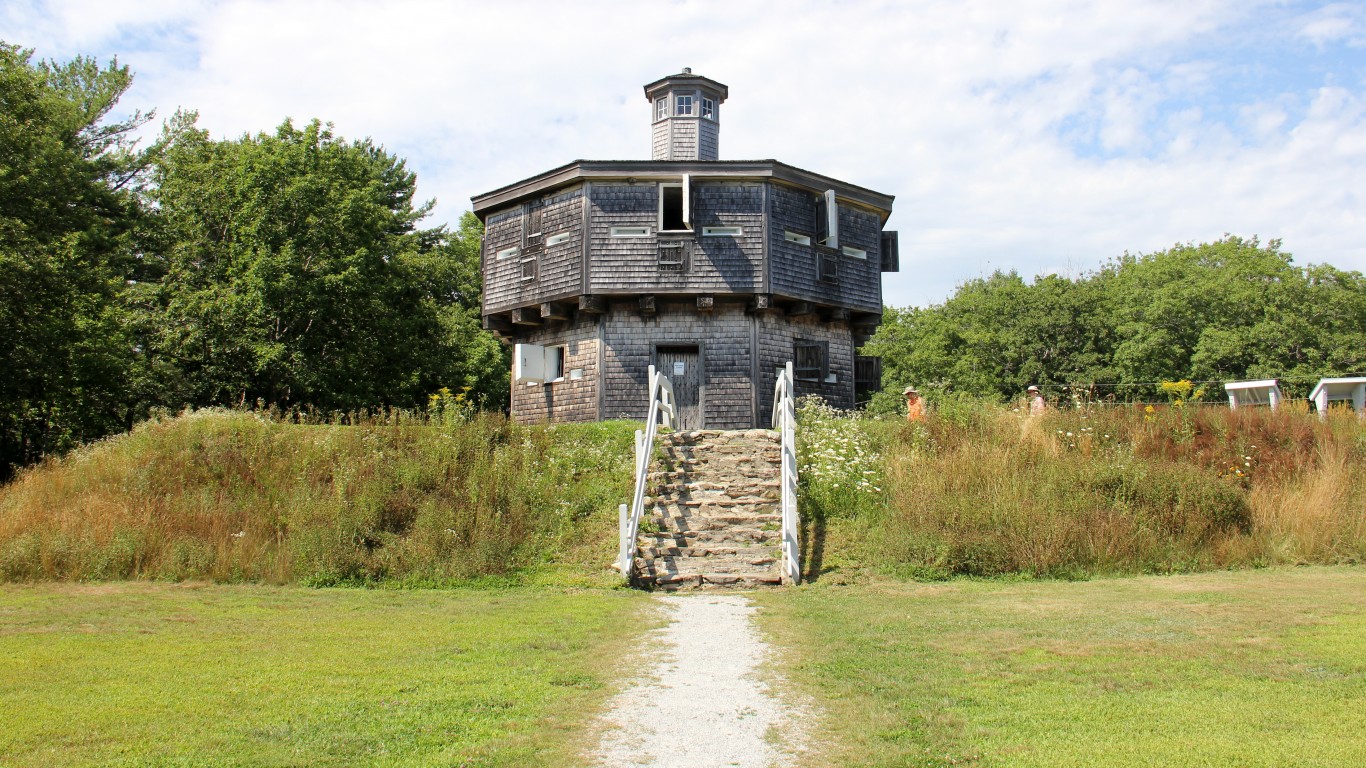
Fort Edgecomb
> Location: Edgecomb, Maine
> Built: 1808
Although built to defend tWiscasset’s shipbuilding industry, Fort Edgecomb was later used to enforce Thomas Jefferson’s Embargo Act of 1807, which banned foreign ships from U.S. ports. The fort housed British prisoners during the War of 1812 and defended against British attacks in 1814. The fort remained in service until 1818, and was later reactivated during the Civil War.
Fort James Jackson
> Location: Savannah, Georgia
> Built: 1808
Constructed between 1808 and 1812 to defend the city of Savannah from sea-based attacks, Fort James Jackson was used by the Confederate army to protect the city during the Civil War. When General William Sherman captured Savannah, his army took over the fort. The U.S. military didn’t use the installation much and it was purchased by the city in 1924 and turned into a park.
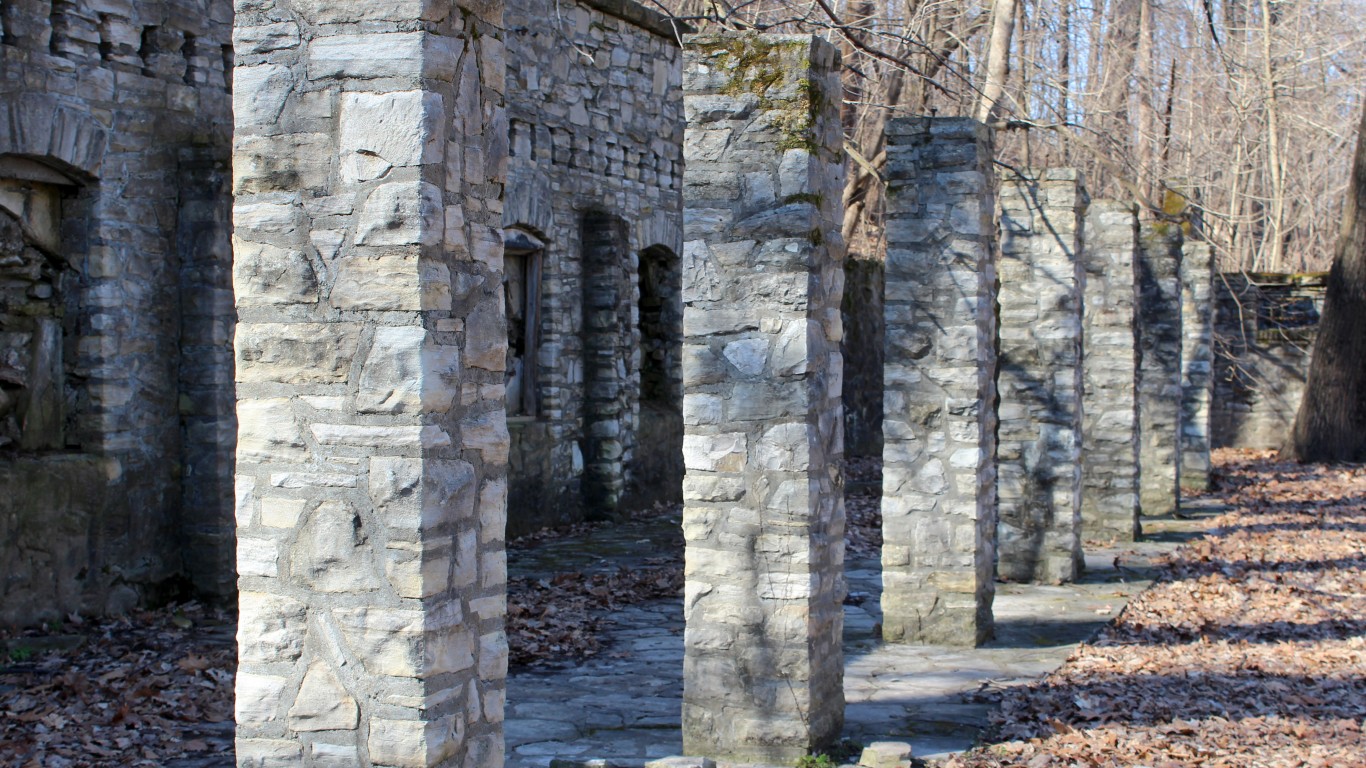
Fort Belle Fontaine
> Location: Old Jamestown, Missouri
> Built: 1805
Fort Belle Fontaine was the first U.S. military fort west of the Mississippi River, in what was then the recently acquired Louisiana Territory. In addition to its military service, the fort served as a starting point for many westward expeditions as well as a fur trading post. The fort housed the regional Army headquarters during the War of 1812.
[in-text-ad-2]

Fort Adams
> Location: Newport, Rhode Island
> Built: 1799
Located at the harbor mouth of Newport Harbor, Fort Adams served as a military fortification from 1841 to the first half of the 20th century. Now under the auspices of the state, Fort Adams hosts the annual Newport Jazz Festival and Newport Folk Festival.
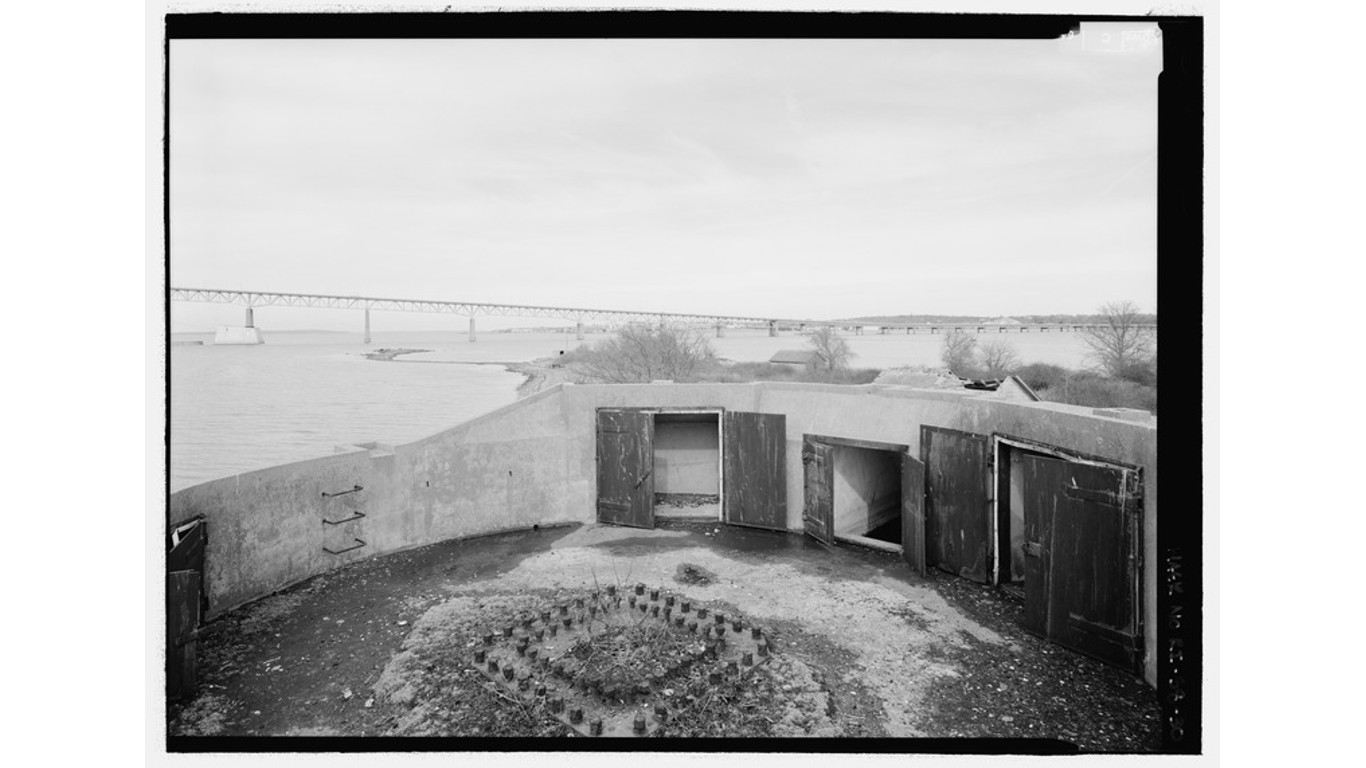
Fort Hamilton
> Location: Rose Island, Rhode Island
> Built: 1798
The first buildings at Fort Hamilton were erected during the Revolutionary War in 1780, with construction continuing from 1798 to 1801. In the late 19th century, the fort served as part of the U.S. Naval Torpedo Station. During World War I and II, it warehoused munitions for the Navy, and anti-aircraft guns were stationed on the island during World War II. In 2001, the fort was added to the National Register of Historic Places.
[in-text-ad]
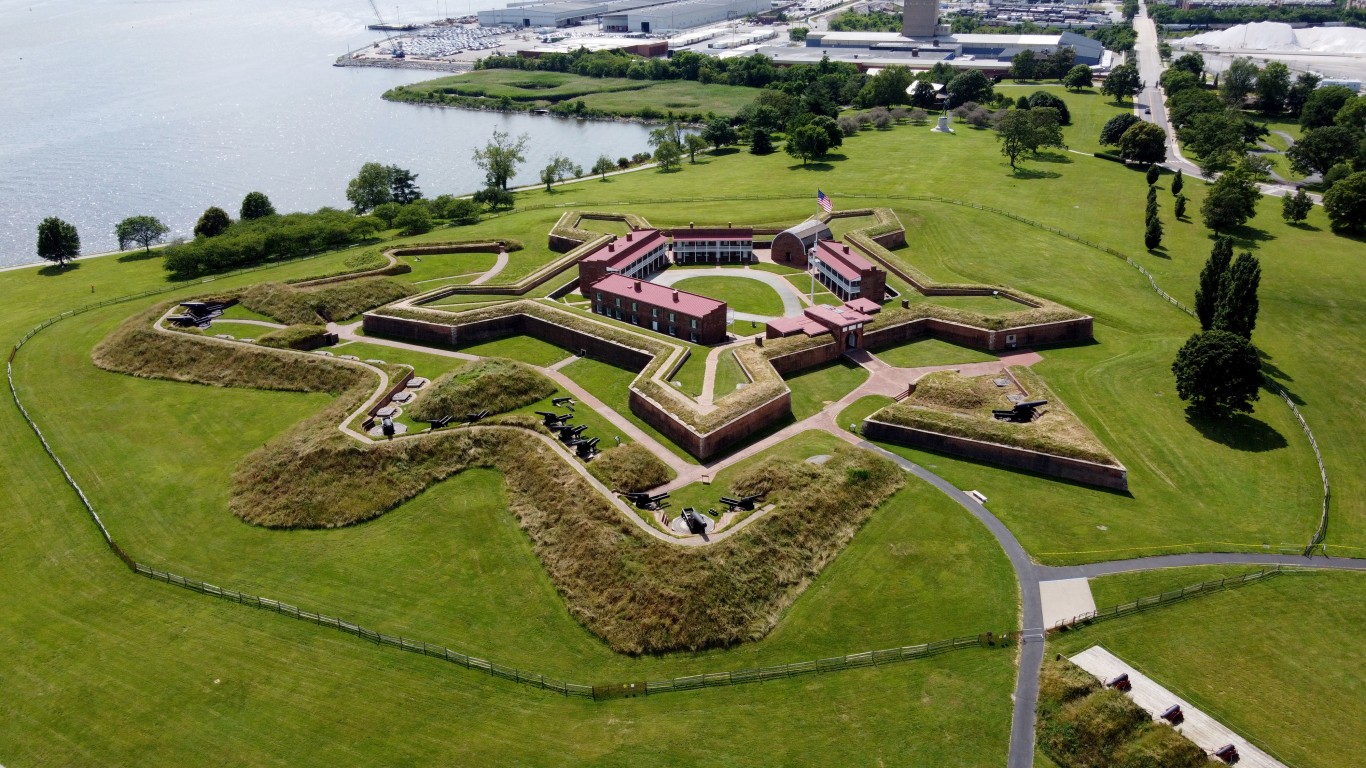
Fort McHenry
> Location: Baltimore, Maryland
> Built: 1798
Although built in 1798, Fort McHenry is best known for its defense of Baltimore Harbor from the British Navy from Sept. 13 to 14, 1814. The American victory and the site of the U.S. flag being flown over the fort inspired Francis Scott Key to write the lyrics to what is now called “The Star-Spangled Banner.” During World War I, the U.S. military occupied the fort, as did the Coast Guard during World War II. It was designated a National Park in 1925.
Fort Southwest Point
> Location: Kingston, Tennessee
> Built: 1797
Overlooking the confluence of the Tennessee and the Clinch rivers, Fort Southwest Point housed federal soldiers from 1797 to 1811. During that time, the frontier station saw clashes between Cherokees and the U.S. government. It also served as a way station for migrants traveling between Knoxville and Nashville. Notably, between the late 1790s and early 1800s, the fort was a recruitment and planning station for the Lewis and Clark Expedition.
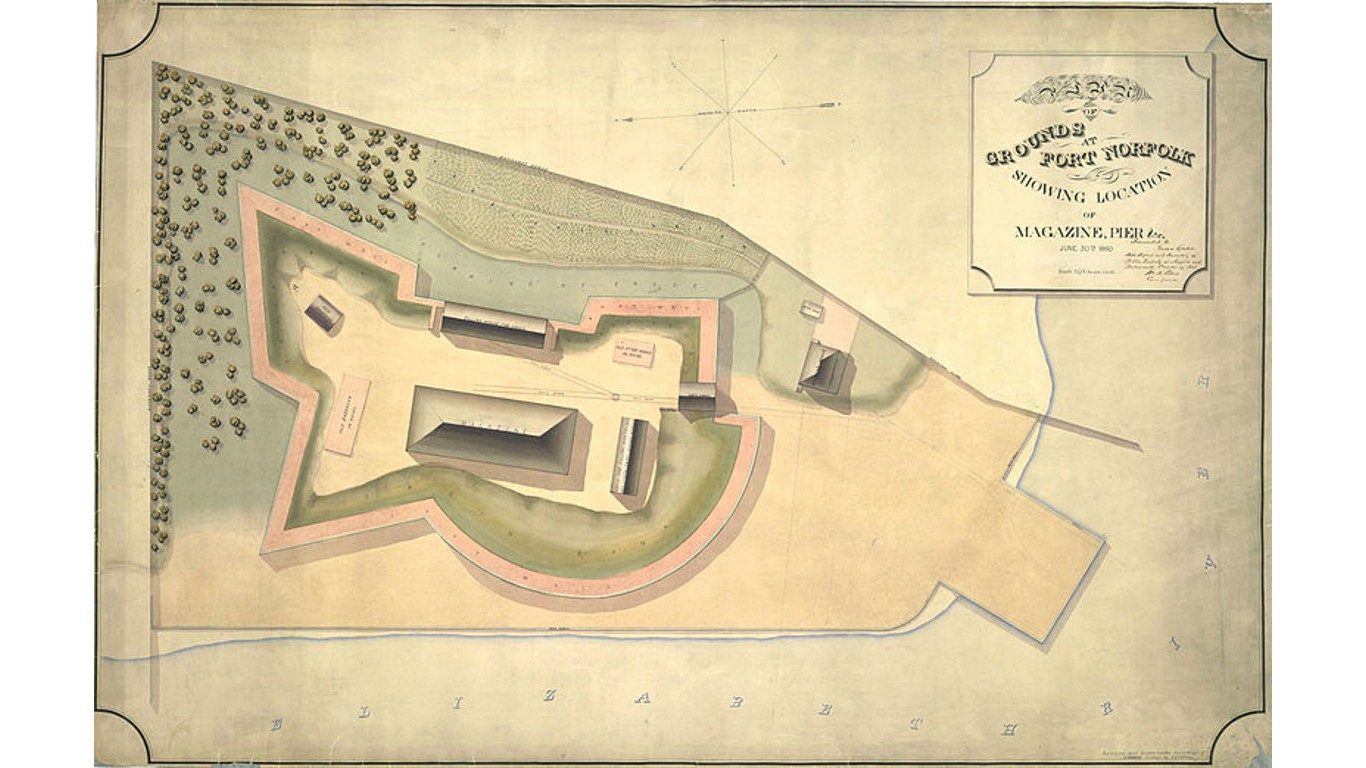
Fort Norfolk
> Location: Norfolk, Virginia
> Built: 1795
President George Washington commissioned Fort Norfolk in 1794 to defend the harbor at the Elizabeth River, and it protected the city during the War of 1812. Confederate forces captured the fort during the Civil War, but Union troops recaptured it in 1862, using it as prison. Fort Norfolk later served as an ordnance depot for the Navy. The U.S. Army Corps of Engineers took over the fort in 1923 and still owns it.
[in-text-ad-2]
Presidio of Santa Barbara
> Location: Santa Barbara, California
> Built: 1782
The Spanish founded the Presidio of Santa Barbara in 1782 as a military installation to defend the Second Military District in California. One of its structures, known as El Cuartel, is the second oldest building in California, after the chapel at Mission San Juan Capistrano. Today, El Presidio de Santa Barbara State Historic Park is a thriving tourist attraction.

Fort Mackinac
> Location: Mackinac Island, Michigan
> Built: 1780
During the Revolutionary War, the British built Fort Mackinac to control the Straits of Mackinac between Lake Michigan and Lake Huron. The British stayed on until 13 years after the Revolutionary War ended. It was also the site of two significant battles during the War of 1812. For most of the 19th century it served as an Army outpost, until its closure in 1895.
[in-text-ad]
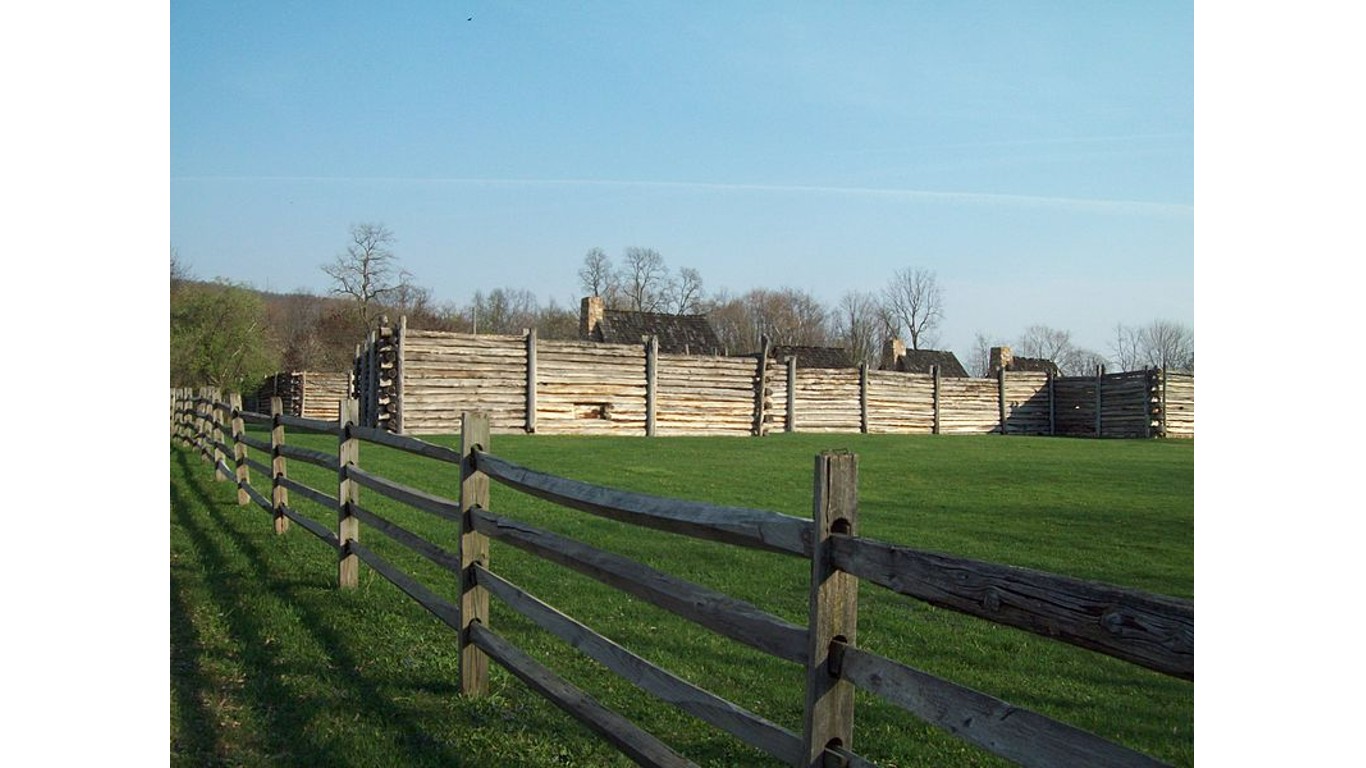
Fort Roberdeau
> Location: Altoona, Pennsylvania
> Built: 1778
Reconstructed
Also known as the Lead Mine Fort, Fort Roberdeau was an active military base from 1776 to 1780. General Daniel Roberdeau constructed the fort to protect the local mining industry from Native Americans and the British. After extensive reconstruction, it was added to the National Register of Historic Places in 1974.

Fort Lee
> Location: Fort Lee, New Jersey
> Built: 1776
Sitting atop the New Jersey Palisades, Fort Lee was originally named Fort Constitution. On Nov. 20, 1776, the British and Hessian troops overtook the bastion as the Continental Army retreated. Overlooking the Hudson River, Fort Lee is now the site of a historical park. Today, the town of Fort Lee is probably best known for its role in the infamous Bridgegate scandal.
Fort Revere
> Location: Hull, Massachusetts
> Built: 1776
Located on Telegraph Hill in Hull Village, the fort was originally named Fort Independence before being renamed in honor of Paul Revere. In 1777, the fort defended Boston Harbor and it maintained its strategic position there until it was decommissioned by the military in 1947. The fort is said to have a haunted, tragic past: When 200 French soldiers fighting for the colonies were freed by the British and taken to the fort, nearly all died of smallpox. Later inhabitants of the fort reported hearing strange noises and seeing unexplained shadows.
[in-text-ad-2]

Presidio of San Francisco
> Location: San Francisco, California
> Built: 1776
The Presidio was originally built by Spain to protect its colonies in the West. Between 1776 and 1821, it guarded California’s largest harbor from attacks from the British and Russians. It also played a role in the Mexican-American War of 1846-48. Until 1994, the Presidio remained an U.S. Army outpost until the fort was decommissioned and turned over to the National Park Service.

Fort Phoenix
> Location: Fairhaven, Massachusetts
> Built: 1775
Built at the entrance of the Fairhaven-New Bedford harbor, and originally given no name, it stood near the first naval battle of the Revolutionary war in Buzzards Bay in 1775. In 1778, the British destroyed the fort, but a counterattack led by Major Israel Fearing fought them off. The fort was named Fort Fearing in his honor, and in 1784 renamed Fort Phoenix because it had risen rom the ashes. It was rebuilt in 1798 and again in 1808. The British ship HMS Nimrod bombarded it in 1814 during the War of 1812, but after an exchange of fire with the local militia the Nimrod sailed away.
[in-text-ad]
Fort Boonesborough
> Location: Boonesborough, Kentucky
> Built: 1775
Founded in 1775 by Daniel Boone, Fort Boonesborough stood as a frontier redoubt until the early 19th century. The outpost saw action during the Revolutionary War and fended off an attack by Native Americans in 1778. After the war, it served as a stopping point for westward settlers and supported the tobacco trade.
Fort Watauga
> Location: Elizabethton, Tennessee
> Built: 1775
Reconstructed
Also known as Fort Caswell, Fort Watauga is named for the Watauga River Valley in what is now northeast Tennessee. The fort was originally settled by European and American arrivals in the late 1760s. During the Revolutionary War, the fort fended off attacks by the Cherokees, said to have been instigated by the British. In July 1776, a Cherokee force attacked the fort and held it for two weeks before withdrawing. The fort played a role in the Revolutionary War in 1780, when the Overmountain Men, a group of frontiersmen from west of the Appalachians, gathered here before setting off to the battle of Kings Mountain in South Carolina. The militia’s victory there helped secure the Southern colonies from the British.
The Average American Has No Idea How Much Money You Can Make Today (Sponsor)
The last few years made people forget how much banks and CD’s can pay. Meanwhile, interest rates have spiked and many can afford to pay you much more, but most are keeping yields low and hoping you won’t notice.
But there is good news. To win qualified customers, some accounts are paying almost 10x the national average! That’s an incredible way to keep your money safe and earn more at the same time. Our top pick for high yield savings accounts includes other benefits as well. You can earn up to 3.80% with a Checking & Savings Account today Sign up and get up to $300 with direct deposit. No account fees. FDIC Insured.
Click here to see how much more you could be earning on your savings today. It takes just a few minutes to open an account to make your money work for you.
Our top pick for high yield savings accounts includes other benefits as well. You can earn up to 4.00% with a Checking & Savings Account from Sofi. Sign up and get up to $300 with direct deposit. No account fees. FDIC Insured.
Thank you for reading! Have some feedback for us?
Contact the 24/7 Wall St. editorial team.
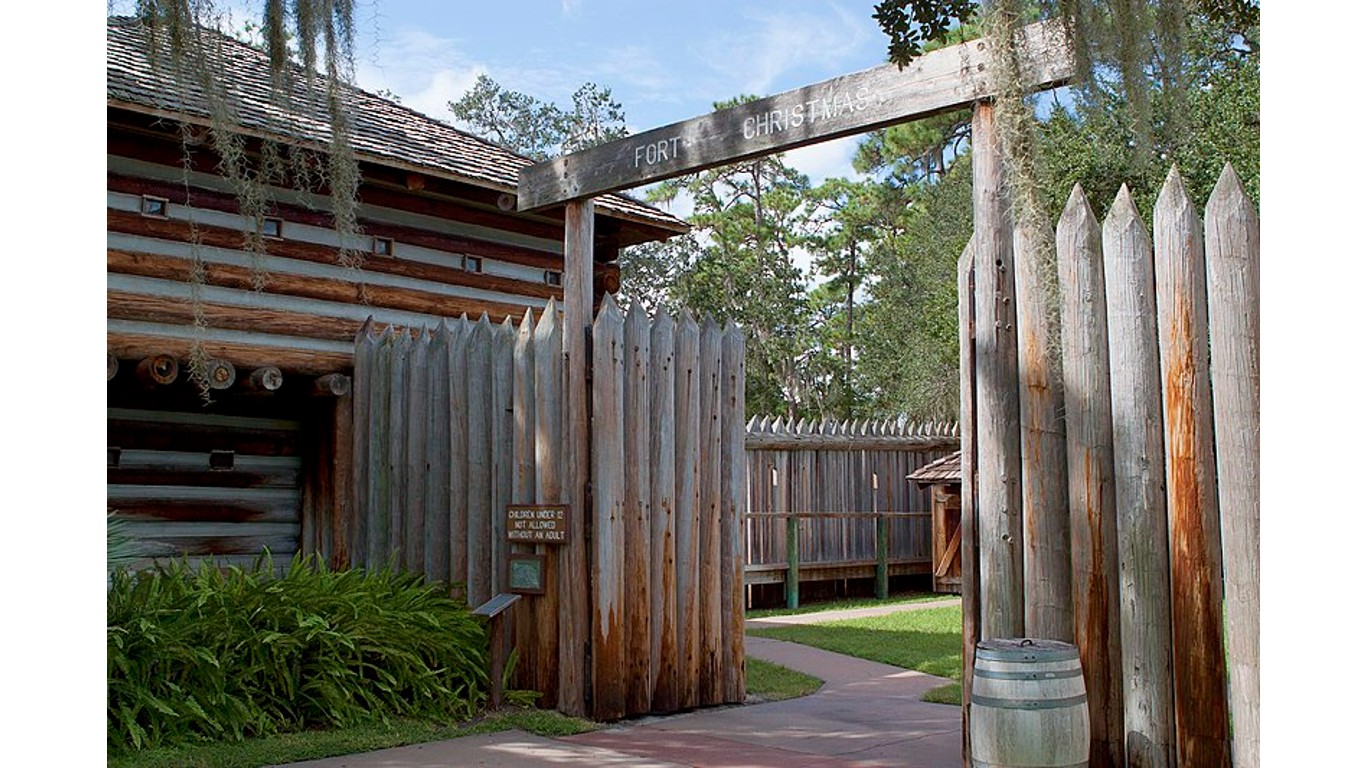

 24/7 Wall St.
24/7 Wall St.
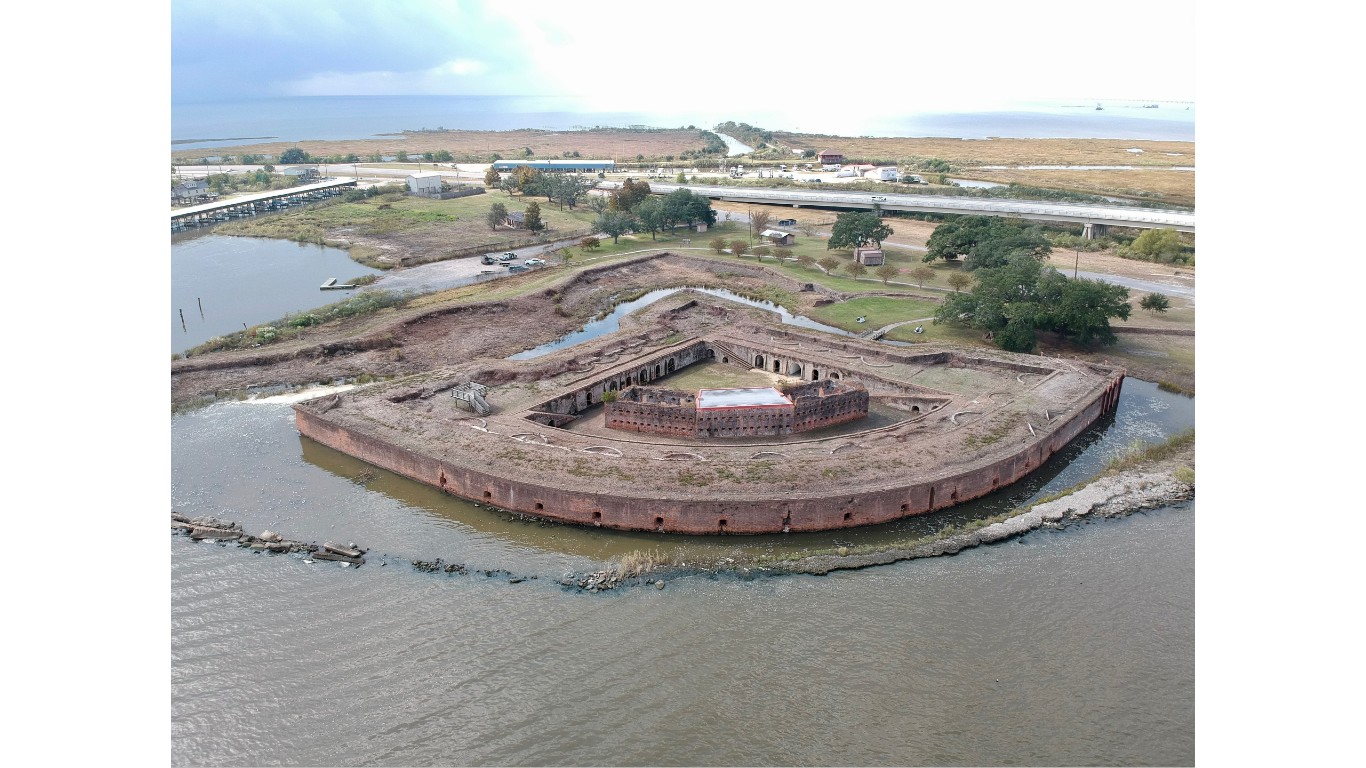
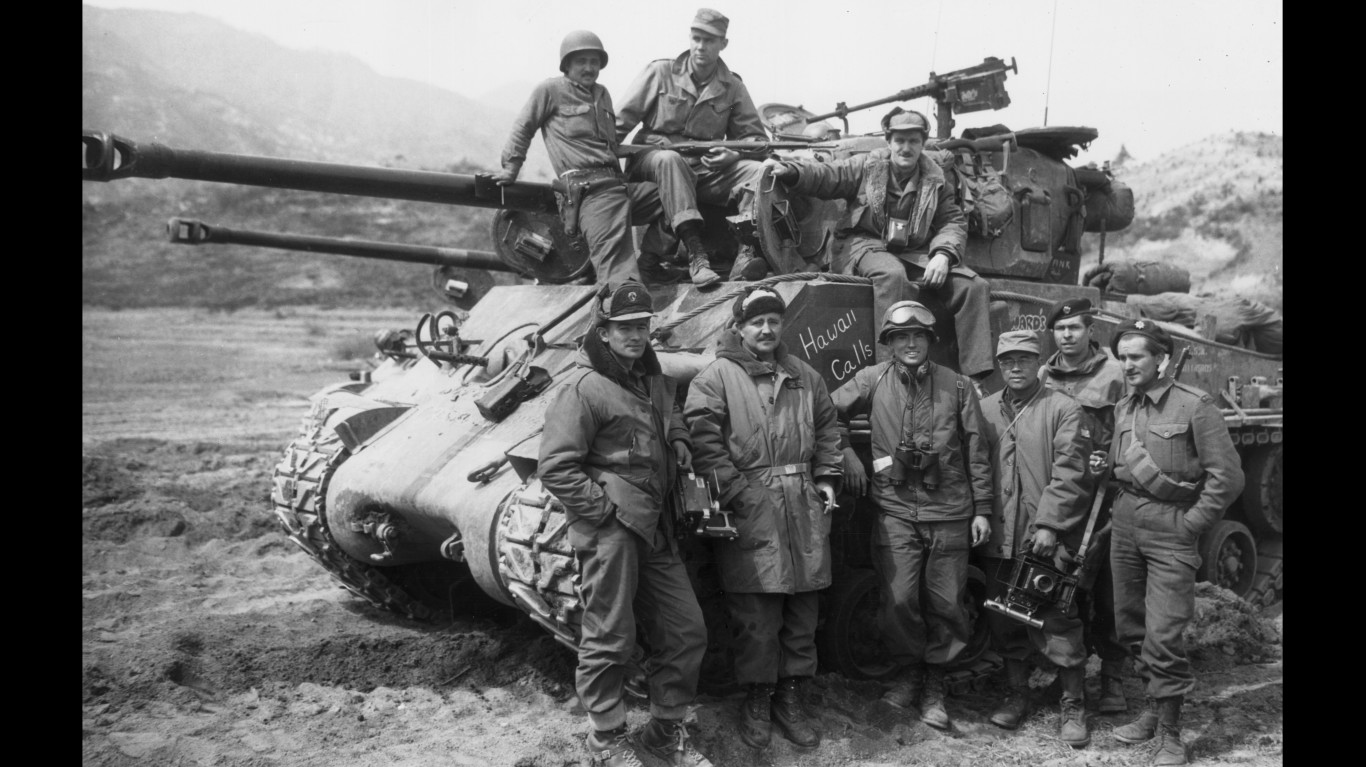 24/7 Wall St.
24/7 Wall St.

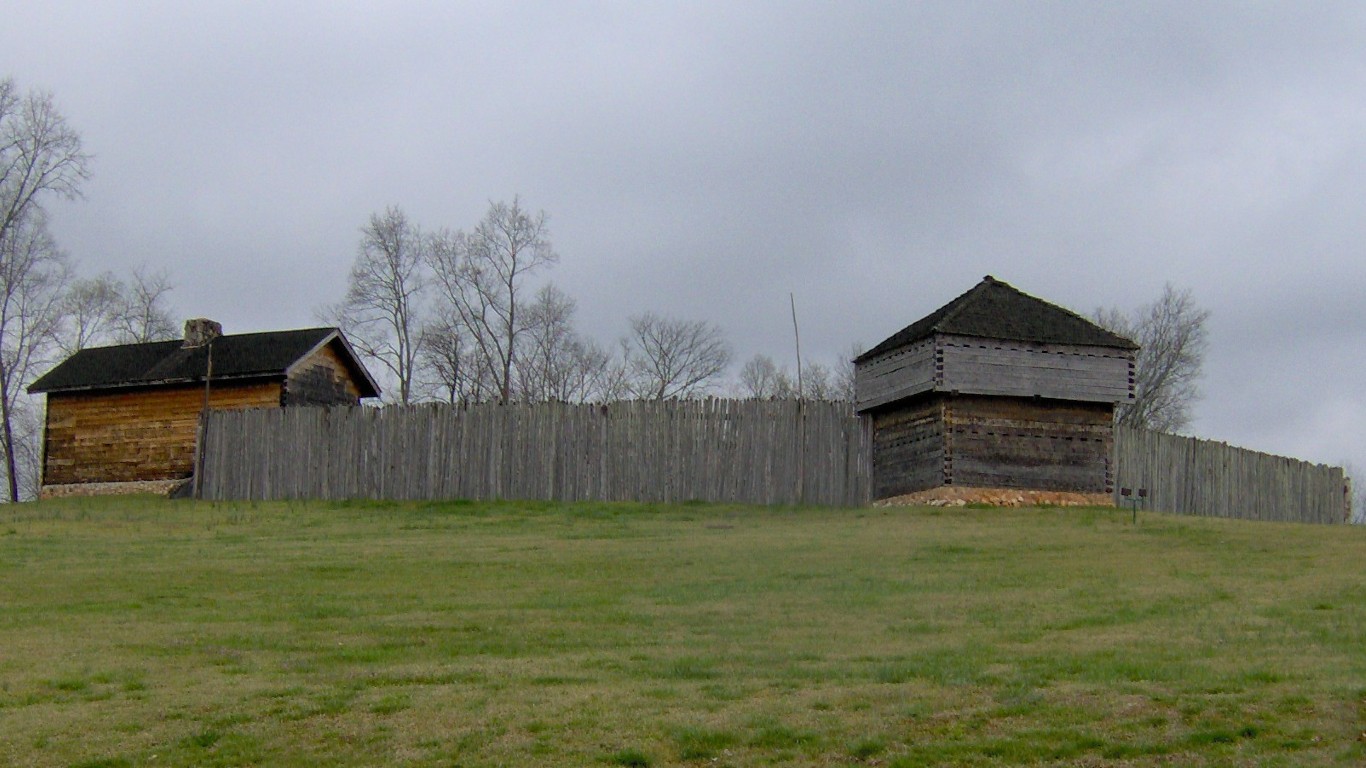
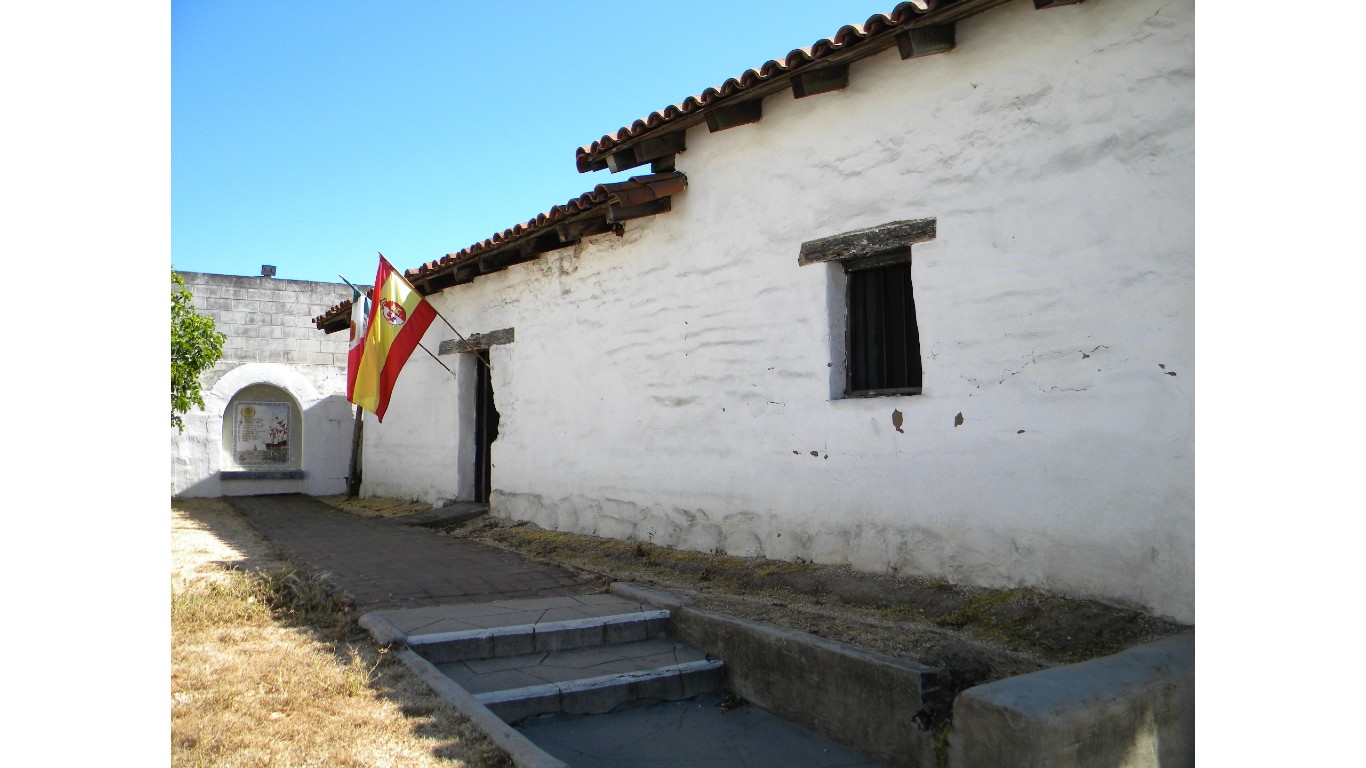
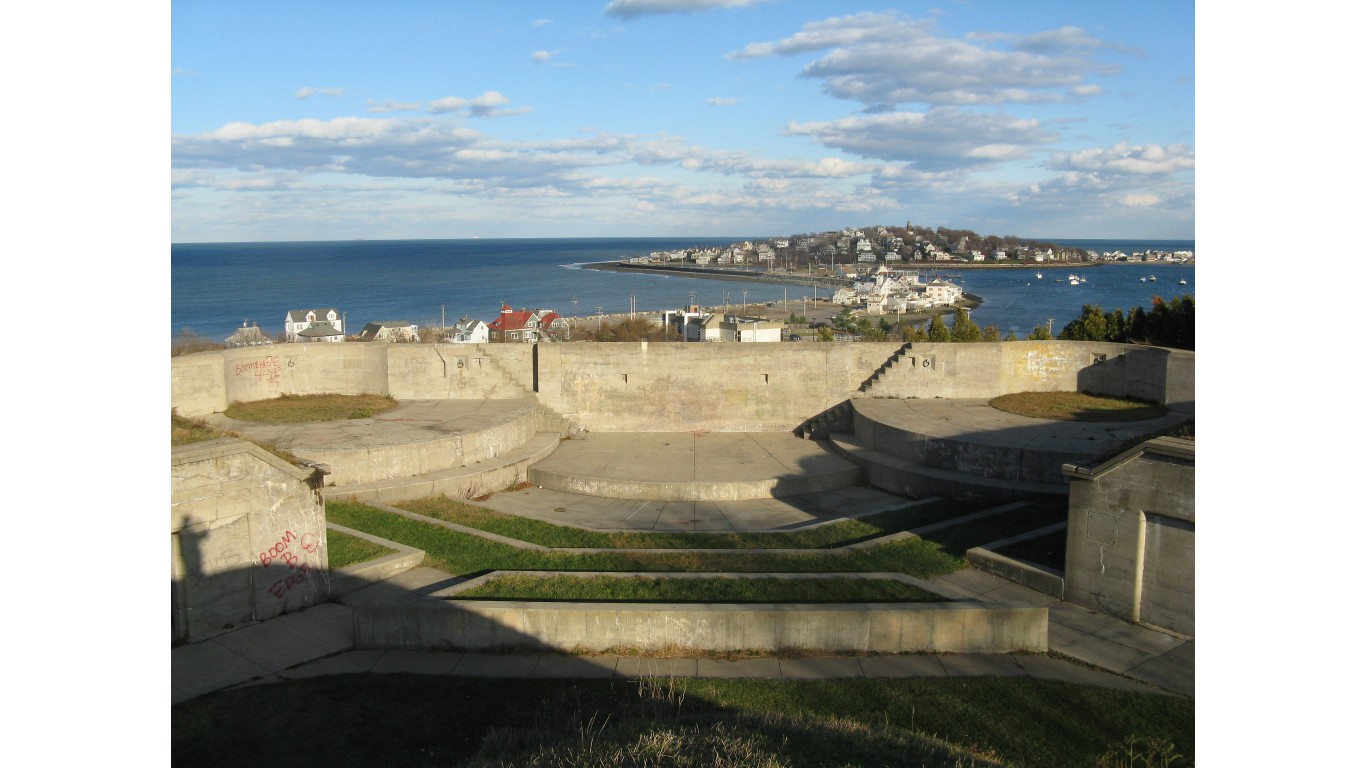
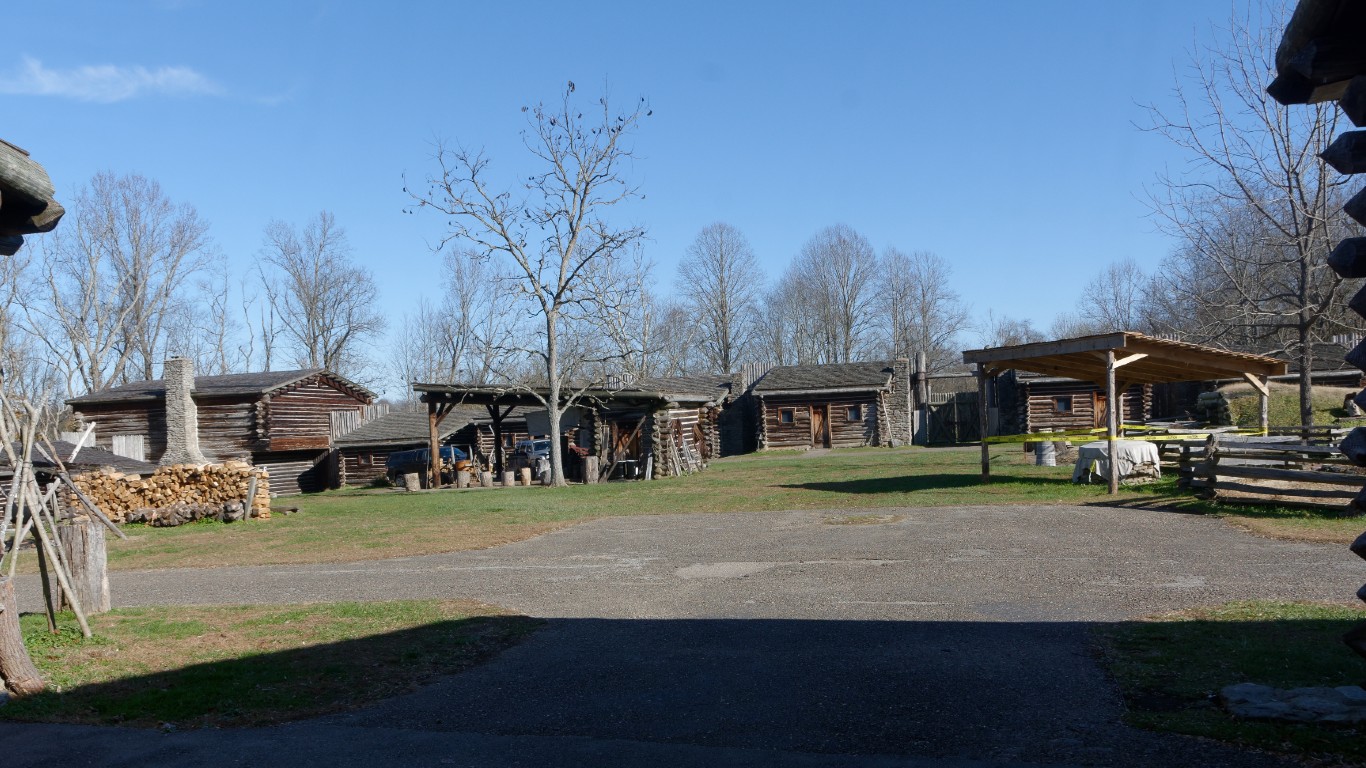
 24/7 Wall St.
24/7 Wall St.